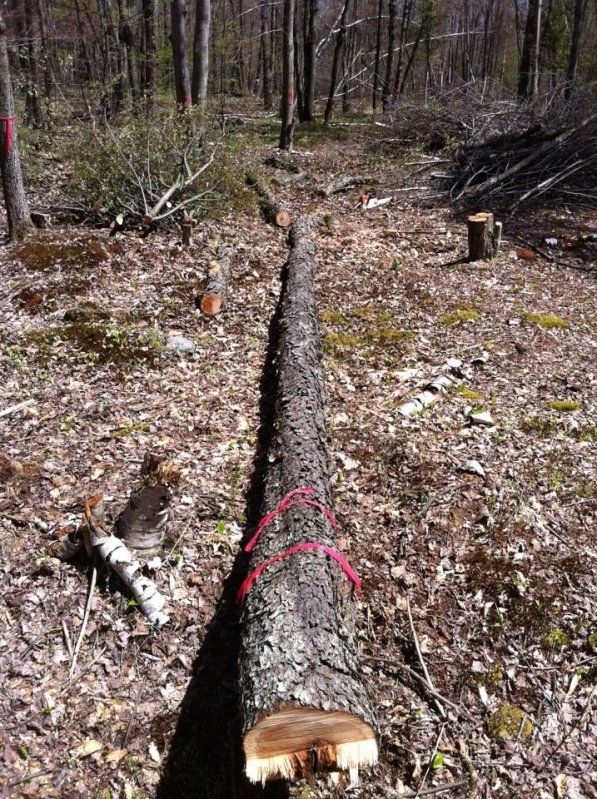|
| Author |
Message |
Swamphunter
Member
|
# Posted: 11 May 2012 12:45am
Reply
OK, so here is the deal. I had to cut down the black cherry tree pictured below. It is very straight for 27'. At the base it has a 12" diameter and tapers down to 10" at the top. I was going to sell the log, but since have decided to make it into a fireplace mantel beam with a hand hewn look since I have a year before my cabin build itself starts. Since I do not have all the tools necessary to actually hew the log from start to finish, Im only going for the appearance of being completely hand hewn. Now that the log is on the ground, I am going to cut it to log lengths and stack them. The exposed ends will be painted to prevent drying to quickly.
How long should I figure on waiting before starting to make my mantel beam out of this log?
Should I wait until late fall and have log rough sawn at a mill into a 4"x 8" beam about 6' feet long. Then start to give it the hewn and aged appearance? Or start later ike over the winter? Is it ok to start now or will it check?
Thanks
|
|
Swamphunter
Member
|
# Posted: 11 May 2012 12:53am
Reply

|
|
Just
Member
|
# Posted: 11 May 2012 09:26am
Reply
paint the ends and start anytime .. cut the log at least a foot longer than you will need, as there is always a chance it will check .
If you could find someone that could use a ad axe it would look much better than sawing the log .
|
|
fpw
Member
|
# Posted: 11 May 2012 10:29am
Reply
Hand hewing isn't hard, anyone can learn. And, if you are just doing a mantel it won't take long. You just need a felling axe (which many folks have) and a hewing axe. Check the antigue/junk stores, you can pick one up for about $30.
When you are dealing with beams, you will get some checking. Even if you anchor seal or paint the ends.
One option would be to run a saw kerf down the back side of the log (that will be against the wall). This will force the check to be out of sight.
You can make the beam now. The wood is probably much easier to work than when it is dry. Just make sure any end-grain is sealed or painted.
|
|
trollbridge
Member
|
# Posted: 11 May 2012 10:59am
Reply
Very cool swamphunter! Exciting to do these things yourself!
Just or fpw......can I ask why the ends would get painted or sealed? I'm just curious---did not know that. Thanks.
|
|
Swamphunter
Member
|
# Posted: 11 May 2012 06:25pm
Reply
Ends get painted so that the log doesn't dry too quickly causing worse checking
|
|
Swamphunter
Member
|
# Posted: 11 May 2012 06:28pm
Reply
Just - I was only having the log rough sawn to approximate size to make the broad axe work a bit easier. I recently had extensive elbow surgery (1 year ago), and too much work with the broad axe could compromise what the surgeon repaired...
|
|
neb
Member
|
# Posted: 11 May 2012 07:51pm
Reply
Awesome
|
|
|
fpw
Member
|
# Posted: 11 May 2012 10:09pm - Edited by: fpw
Reply
Trollbridge,
All logs check. Look at any log building or timber frame stucture and you will see checking in every log or timber. With the larger size material, there isn't much you can do about checking...it will occur You can slow it down by sealing any end grain (the log ends or any mortise and tenons you cut). Painting works ok; however, there is product called Anchor Seal (wax base) which I think works very well.
Because the material will check, one technique that works to control the checking is to run a saw kerf to the center of the log on the side you want the check to occur. A check will always start close to the heart of the timber. If you cut a kerf that gets close to the heart, the check will start there; you can factor this into the end result of the project. By using a saw kerf, you can control where the checking will showup (i.e. if your run a kerf near the the center (pith) the log will check on your kerf).
For example: many hand scribed log builders will run a saw kerf down the top of of a log before installing the next log. This keeps the checking on the top of the log and the scribed lower portion of the new log will not check. This assures a tight fit for the next few centuries.
In the attached photo you can see the checking started. This a 6"x8" beam, which was coated with anchor seal. You can see the check starting on the tie beam. It starts from the tenon which was the cut that was closest to the heart of the timber.
This checking had no adverse affect on the structure (10'x 12' timber framed shed).
|
|
trollbridge
Member
|
# Posted: 15 May 2012 11:28am
Reply
Thank you!
I learn such interesting stuff here. I knew all logs will check as they dry but I never thought about sealing the ends to slow it down. I've also read that checking doesn't compromise the strength of the log but is there ever a point where it would? It doesn't make logical sense to me, especially if the log is being used as a beam.
|
|
|

